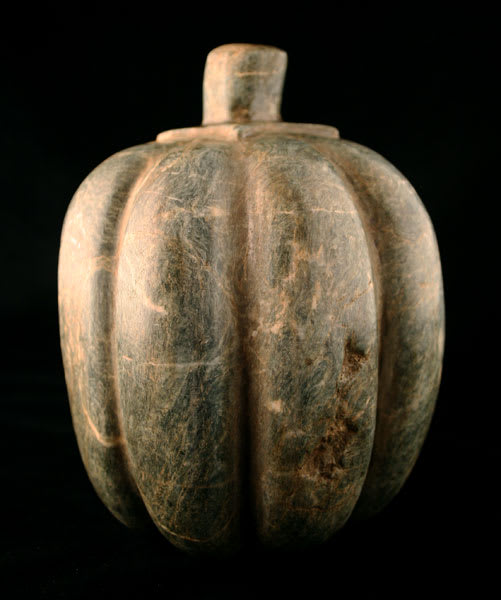Aztec Green Stone Sculpture of a Cacao Pod, 1300 CE - 1550 CE
Stone
5 x 7.25 x 4.75
CK.0103
Further images
The Aztec civilization is perhaps the most celebrated of the ancient Mesoamerican cultures. Their empire stretched throughout northern Mexico and was surpassed in size only by that of the Incans....
The Aztec civilization is perhaps the most celebrated of the ancient Mesoamerican cultures. Their empire stretched throughout northern Mexico and was surpassed in size only by that of the Incans. Tenochtitlan (modern-day Mexico City) was the center of their religious and political systems. The city was composed of a group of island located in the center of Lake Texcoco, earning it the nickname “Venice of the New World.” By the time the Spanish Conquistadors arrived in the early 16th Century, led by the infamous Hernan Cortes, Tenochtitlan was by far larger than any city they could have seen in Europe. Today, the Aztec are remembered for their grand temple complex ruins, for their intricate calendar system, and for the few examples of their art that survive today. Aztec art was primarily ecclesiastical and is renowned for its powerful nature. Highly adept at working with stone, the Aztec artists created artworks that were both grand in scale, as evidenced in their temple architecture, and relatively small in size. Like many cultures, the Aztecs believed that many animals had supernatural symbolic associations. Therefore, although the Aztec gods were usually visualized in human form, most gods also had animal aspects. Moreover, it was believed that both men and gods could, at certain times, actually change themselves into powerful animals.
Cacao pods and their seeds contained within were highly valued by the Aztec civilization, both in and of themselves, and for the chocolate drink produced from their seeds. In fact, the cacao seeds were used in Pre-Columbian Mexico as a form of currency. The Aztec king was paid annual taxes in cacao seeds. When Cortez met with King Montezuma, he recorded the strange, frothy beverage the leader consumed with such gusto and how his servants vigorously whipped the drink during preparation. The Aztecs and the other cultures of Pre-Columbian Mexico that came before them mixed the seeds with chilies, vanilla, and other such flavorings. The drink was valued for its flavor and medicinal properties. Considering that the seeds were themselves a form a currency, drinking this beverage was akin to drinking money and thus an ultimate status symbol. Elongated and segmented, the cacao pods resemble a squash vegetable and are well known in Aztec art.
Cacao pods and their seeds contained within were highly valued by the Aztec civilization, both in and of themselves, and for the chocolate drink produced from their seeds. In fact, the cacao seeds were used in Pre-Columbian Mexico as a form of currency. The Aztec king was paid annual taxes in cacao seeds. When Cortez met with King Montezuma, he recorded the strange, frothy beverage the leader consumed with such gusto and how his servants vigorously whipped the drink during preparation. The Aztecs and the other cultures of Pre-Columbian Mexico that came before them mixed the seeds with chilies, vanilla, and other such flavorings. The drink was valued for its flavor and medicinal properties. Considering that the seeds were themselves a form a currency, drinking this beverage was akin to drinking money and thus an ultimate status symbol. Elongated and segmented, the cacao pods resemble a squash vegetable and are well known in Aztec art.









